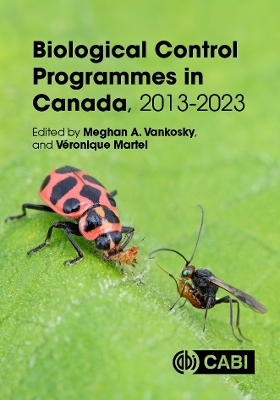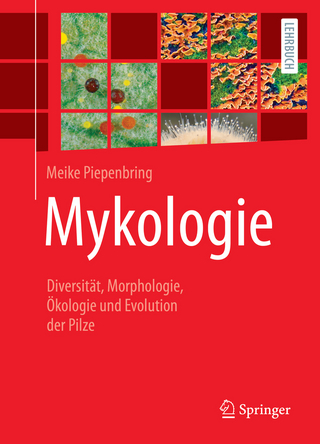
Biological Control Programmes in Canada, 2013-2023
CABI Publishing (Verlag)
978-1-80062-325-5 (ISBN)
Biological control is an important component of integrated and ecological pest management programmes. Its importance continues to increase as plant protection is challenged with climate change, invasive species, pesticide resistance, de-registration of pesticide active ingredients, and increasing consumer demands for sustainably produced food and fibre. Biological control is highly compatible with organic cropping systems and evolving pest management frameworks, including biovigilance. Canada continues to be a world leader in biological control research, development of biological control policy, and implementation of biological control programmes. This is the sixth volume of a series of books reporting on the status of biological control research and on biological control programmes employed in Canada. This volume features 58 case study chapters that describe the research and progress in implementation of biological control for pests including insects, mites, weeds, and plant pathogens. Topics important to biological control, including policy, emerging technologies, biological control in urban landscapes and future targets for biological control are reviewed. Although the volume focusses on the Canadian biological control experience, the chapters will be of interest to a global audience of researchers and students of biological control, risk assessment, ecology, and pest management. This book Offers a detailed analysis of the state-of-the-art of biological control in Canada. Explains how biological control research is responding to challenges including climate change and invasive alien species. Gives insights in effective risk assessment and pest management. It is a valuable resource for students and researchers of pest management and biological control, and for practitioners and policy-makers needing analysis of the practical implications of using this approach.
Meghan A. Vankosky (Edited By) Dr Vankosky has worked on various aspects of biological control of agricultural pests during her academic training and as part of her current position as a research scientist at the Saskatoon Research and Development Centre. Projects include identifying potential natural enemies of an invasive weevil in Alberta (M.Sc. research project, 2008-2010), understanding tri-trophic interactions involving an omnivorous Hemipteran used for greenhouse biological control (Ph.D. thesis, 2010-2015), and the release of an imported parasitoid in an urban biological control program for Asian citrus psyllid in California (PDF, 2015-2016). Since joining Agriculture and Agri-Food Canada (AAFC), Dr Vankosky has been an active member of the AAFC Biological Control Working Group (current Secretary), has continued research focused on biological control of field crop pests, and is the Chair of the Prairie Pest Monitoring Network. She advocates for beneficial insects, including predators and parasitoids, in her research and in extension activities. Dr Vankosky has authored or co-authored 22 peer-reviewed manuscripts, one book chapter, over 50 presentations (invited and submitted to conferences and meetings), gives regular guest lectures at major prairie universities, and has contributed to >100 reports and media articles since 2016 Véronique Martel (Edited By) Dr Martel has a M.Sc. (2003) and a Ph.D. (2007) in entomology from McGill University in collaboration with Agriculture and Agri-Food Canada (AAFC). After graduating, she went to Europe for two postdocs positions, first in Sweden (2007-09) and then in France (2009-11). She started as a research scientist for Natural Resources Canada in 2011, where she works on forest insect pests (such as spruce budworm and emerald ash borer) and their natural enemies. Her work has been recognized through nine awards from the Entomological Societies of Québec and Canada as well as the Federal Government, including awards for her work in support of women in science and bilingualism for minority communities. She authored 37 peer-reviewed publications, 2 book chapters and 51 reports or non peer-reviewed publications. She has been an invited speaker for more than 50 conferences, both international and national, and gave 30 regular talks, in addition to the more than 100 conference talks on which she is a co-author. She has supervised or co-supervised 19 graduate students and 12 undergrads from four countries, in addition to being involved in different roles in the committees of 22 graduate students. She is actively involved in different societies, including the Entomological Societies of Québec, Canada and America. Finally, she is frequently contacted by reporters for her expertise, which led to more than 50 media interviews for newspaper, radio, television, podcast or online medias. Her training with AAFC combined with her current position with CFS gives her a global understanding of biological control in both agriculture and forestry.
Introduction and Special Topics: Introduction and Special Topics 1.: A Brief History of Biological Control in Canada. 2.: Regulation of Biological Control Organisms in Canada. 3.: The Use of UAS in Biological Control in Canada. 4.: Biological Control in Novel Urban Forest Ecosystems. 5.: Potential Targets of Biological Control Programmes in Canada. A.: Arthropod Targets of Biological Control 6.: Acalymma vittatum (Fabricius), Striped Cucumber Beetle (Coleoptera: Chrysomelidae). 7.: Acrolepiopsis assectella (Zeller), Leek Moth (Lepidoptera: Acrolepiidae). 8.: Adelges tsugae Annand, Hemlock Woolly Adelgid (Hemiptera: Adelgidae). 9.: Agrilus planipennis Fairmaire, Emerald Ash Borer (Coleoptera: Buprestidae). 10.: Agriotes spp. Eschscholtz and other Elaterids (Coleoptera: Elateridae), Wireworms and Click Beetles. 11.: Anthonomus eugenii Cano, Pepper Weevil (Coleoptera: Curculionidae). 12.: Anthonomus rubi Herbst, Strawberry Blossom Weevil (Coleoptera: Curculionidae). 13.: Aphis gossypii Glover, melon/cotton aphid; Aulacorthum solani (Kaltenbach), foxglove aphid (Hemiptera: Aphididae) and other aphid pests of greenhouse crops. 14.: Bemisia tabaci (Gennadius), Sweet Potato Whitefly and Trialeurodes vaporariorum Westwood, Greenhouse Whitefly (Hemiptera: Aleyrodidae). 15.: Cephus cinctus Norton, Wheat Stem Sawfly (Hymenoptera: Cephidae). 16.: Ceutorhynchus obstrictus (Marsham), Cabbage Seedpod Weevil (Coleoptera: Curculionidae). 17.: Choristoneura fumiferana (Clemens), Eastern Spruce Budworm (Lepidoptera: Tortricidae). 18.: Contarinia nasturtii (Kieffer), Swede Midge and Contarinia brassicola Sinclair, Canola Flower Midge (Diptera: Cecidomyiidae). 19.: Cutworms (Lepidoptera: Noctuidae) Affecting Crops on the Canadian Prairies. 20.: Dasinuera mali (Kieffer), Apple Leaf-curling Midge (Diptera: Cecidomyiidae). 21.: Delia antiqua Meigen, Onion Maggot (Diptera : Anthomyiidae). 22.: Dendroctonus ponderosae (Hopkins), Mountain Pine Beetle (Coleoptera: Curculionidae). 23.: Drosophilia suzukii (Matsumura), Spotted-wing Drosophila (Diptera : Drosophilidae). 24.: Frankliniella occidentalis (Pergande), Western Flower Thrips, Thrips tabaci (Lindeman), Onion Thrips (Thysanoptera: Thripidae) and Other Pest Thrips in Greenhouse Crops. 25.: Halyomorpha halys Stål, Brown Marmorated Stink Bug (Hemiptera: Pentatomidae). 26.: Hoplocampa testudinea Klug, European Apple Sawfly (Hymenoptera: Tenthredinidae). 27.: Hypera postica (Gyllenhal), Alfalfa Weevil (Coleoptera: Curculionidae). 28.: Lilioceris lilii (Scopoli), Lily Leaf Beetle (Coleoptera: Chrysomelidae). 29.: Listronotus oregonensis (LeConte), Carrot Weevil (Coleoptera: Curculionidae). 30.: Lygus spp. Plant Bugs (Hemiptera: Miridae). 31.: Mamestra configurata Walker, Bertha Armyworm (Lepidoptera: Noctuidae). 32.: Orchestes fagi (L.), Beech Leaf Mining Weevil (Coleoptera: Curculionidae). 33.: Ostrinia nubilalis (Hübner), European Corn Borer (Lepidoptera: Crambidae). 34.: Oulema melanoplus L., Cereal Leaf Beetle (Coleoptera: Chrysomelidae). 35.: Phytonemus pallidus (Banks), Cyclamen Mite (Trombidiformes: Tarsonemidae). 36: Plutella xylostella (L.), Diamondback Moth (Lepidoptera: Plutellidae). 37.: Popillia japonica Newman, Japanese Beetle (Coleoptera: Scarabaeidae). 38.: Rhopobota naevana (Hübner), Blackheaded Fireworm (Lepidoptera: Tortricidae). 39.: Sitodiplosis mosellana (Géhin), Orange Wheat Blossom Midge (Diptera: Cecidomyiidae). 40.: Sitona lineatus (L.), Pea Leaf Weevil (Coleoptera: Curculionidae). 41.: Striacosta albicosta (Smith), Western Bean Cutworm (Lepidoptera: Noctuidae). 42.: Synanthedon myopaeformis (Borkhausen), Apple Clearwing Moth (Lepidoptera: Sesiidae). 43.: Tetranychus urticae Koch, Two-spotted Spider Mite (Trombidiformes: Tetranychidae), Polyphagotarsonemus latus (Banks), Broad Mite (Trombidiformes: Tarsonemidae), and other mites in greenhouses. 44.: Trichoplusia ni (Hübner), Cabbage Looper (Lepidoptera: Noctuidae). 45.: Varroa destructor Anderson & Trueman, Varroa Mite (Mesostigmata: Varroidae). B.: Weed Targets of Biological Control 46.: Ailanthus altissima (Miller) Swingle, Tree of Heaven (Simaroubaceae). 47.: Alliaria petiolata (M.Bieberstein) Cavara & Grande, Garlic Mustard (Brassicaceae). 48.: Centaurea stoebe subsp. micranthos (Gugler) Hayek, Spotted Knapweed and Centaurea diffusa Lamarck, Diffuse Knapweed (Asteraceae). 49.: Cirsium arvense (L.) Scopoli, Canada Thistle (Asteraceae). 50.: Convolvulus arvensis L., Field Bindweed (Convolvulaceae). 51.: Elaeagnus angustifolia L., Russian Olive (Elaeagnaceae). 52.: Fallopia japonica (Houtt.) Ronse Decraene, Japanese Knotweed, Fallopia sachalinensis (F. Schmidt) Ronse Decraene, Giant Knotweed, Fallopia x bohemica (Chrtek & Chrtkova) J. P. Bailey, Bohemian Knotweed (Polygonaceae). 53.: Lepidium draba L., Lepidium chalepense L. and Lepidium appelianum Al-Shehbaz, Hoary Cresses Cranson rampant and Cranson velu (Brassicaceae). 54.: Leucanthemum vulgare Lamarck, Oxeye Daisy (Asteraceae). 55.: Linaria dalmatica (L.) Miller, Dalmatian Toadflax and Linaria vulgaris Miller, Yellow Toadflax (Plantaginaceae). 56.: Myriophyllum aquaticum (Vellozo) Verdcourt, Parrot’s Feather (Haloragaceae). 57.: Phragmites australis subsp. australis (Cavanilles) Trinius ex Steudel, European Common Reed (Poaceae). 58.: Pilosella spp., Hawkweeds (Asteraceae). 59.: Rhaponticum repens (L.) Hidalgo, Russian Knapweed (Asteraceae). 60.: Tanacetum vulgare L., Common Tansy (Asteraceae). 61.: Vincetoxicum nigrum (L.) Moench, Pale Swallow-wort and Vincetoxicum rossicum (Kleopow) Barbaricz, Black Swallow-wort (Apocynaceae). C.: Pathogen Targets of Biological Control 62.: Phytophthora infestans (Montagne) de Bary, Potato Late Blight (Pythiaceae). 63.: Phytophthora ramorum Werres, de Cock & Man in’t Veld, Sudden Oak Death (Peronosporaceae).
| Erscheinungsdatum | 21.08.2024 |
|---|---|
| Co-Autor | Paul K. Abram, Susanna Acheampong, Patrice Audy |
| Verlagsort | Wallingford |
| Sprache | englisch |
| Maße | 172 x 244 mm |
| Themenwelt | Naturwissenschaften ► Biologie ► Botanik |
| Naturwissenschaften ► Biologie ► Zoologie | |
| Weitere Fachgebiete ► Land- / Forstwirtschaft / Fischerei | |
| ISBN-10 | 1-80062-325-9 / 1800623259 |
| ISBN-13 | 978-1-80062-325-5 / 9781800623255 |
| Zustand | Neuware |
| Informationen gemäß Produktsicherheitsverordnung (GPSR) | |
| Haben Sie eine Frage zum Produkt? |
aus dem Bereich


